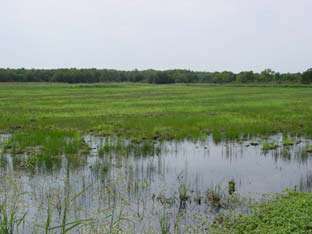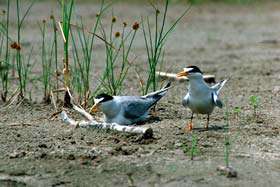Hagerman National Wildlife Refuge
category : Wildlife Refuges
 Hagerman National Wildlife Refuge lies on the Big Mineral Arm of Lake Texoma, on the Red River between Oklahoma and Texas. Established in 1946, the refuge includes 3,000 acres of marsh and water and 8,000 acres of upland and farmland. During fall, winter, and spring, the marshes and waters are in constant use by migrating and wintering waterfowl.
Hagerman National Wildlife Refuge lies on the Big Mineral Arm of Lake Texoma, on the Red River between Oklahoma and Texas. Established in 1946, the refuge includes 3,000 acres of marsh and water and 8,000 acres of upland and farmland. During fall, winter, and spring, the marshes and waters are in constant use by migrating and wintering waterfowl.Auto Tour Road
A 4-mile self-guided auto tour route is located in the main management unit of the refuge. Leaflets and roadside exhibits provide information on the area and the refuge programs.
Boating
Boating is permitted only from April through Spetember. Boats may be launched only at designated launch sites.
Fishing
Fishing in Lake Texoma is permitted year-round in accordance with state regulations, during daylight hours only. To protect waterfowl, fishing in refuge ponds is allowed only from April through September. Trot lines may not be attached to any fixed objects (jug-to-jug only). Fishing from bridges is prohibited.
Hiking
The interpretive Crow Hill Trail, off Silliman Road, offers a close look at native prairie habitat. Hiking/foot access is restricted only during hunting seasons. Hikers should watch for poisonous snakes. Insect repellant is suggested during warm weather as protection from ticks and chiggers.
Wildlife Watching
Sightseeing, nature study, birdwatching, and photography are year-round activities. Fall and winter months offer the best chance for seeing migrating ducks, geese, and pelicans. Excellent viewing is available along the main lakeshore. The focus at Hagerman NWR is to provide a winter home for thousands of waterfowl each year.
Foremost among waterfowl at the refuge are Canada geese. During fall, winter, and spring numbers can reach 7,500 or more. Other geese include white-fronted, snow, and the smaller Ross' geese.
During the southern migration in the fall, dabbling ducks such as mallard, pintail, and teal, and diving ducks such as redhead, ringneck, and scaup arrive at Hagerman NWR. Many spend the winter on the refuge, rejoining waterfowl from more southern climes for the spring migration.
Other birds abound, too. Shorebird migration in July can be spectacular. Pelican flights in April and September are a striking sight. Wading birds are common throughout the warm months.
The upland habitat at Hagerman NWR provides a home for many songbirds, quail, dove, small game, white-tailed deer, and a host of other native animals--furred, feathered, and scaled.
Wildlife Viewing Tips
* Dawn and dusk are the best times to see wildlife. In warmer climates, little is moving on hot summer afternoons or on windy days.
* Observe from the sidelines. Leave "abandoned" young animals alone. A parent is probably close by waiting for you to leave. Don't offer snacks; your lunch could disrupt wild digestive systems.
* Cars make good observation blinds. Drive slowly, stopping to scan places wildlife might hide. Use binoculars or a long lens for a closer look.
* Try sitting quietly in one good location. Let wildlife get used to your presence. Many animals that have hidden will reappear once they think you are gone. Walk quietly in designated areas, being aware of sounds and smells.
* Often you will hear more than you will see.
* Teach children quiet observation. Other wildlife watchers will appreciate your consideration.
* Look for animal signs. Tracks, scat, feathers and nests left behind often tell interesting stories.
Phone: 903-786-2826
Our Email: fw2_rw_hagerman@fws.gov
Our Website:www.fws.gov/southwest/refuges/texas/hagerman
From Dallas, go north on Highway 75 to Sherman FM 1417 exit, then north 13 miles on FM 1417 to refuge sign and left 6 miles to entrance. From U.S. 82, turn north on Southmayd Road (4 miles east of Sadler and 7.5 miles west of Sherman). Follow signs to office and visitor center.
Come visit us in Lake Texoma, Texas